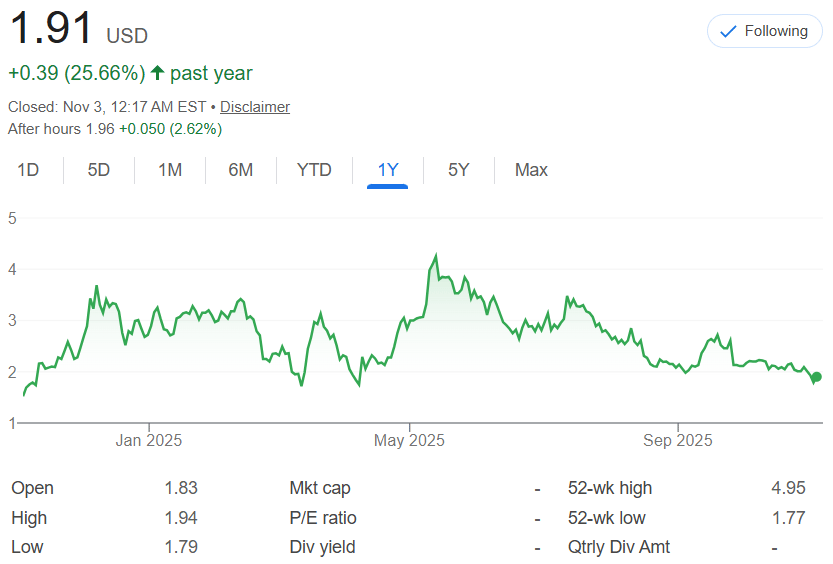
Opendoor is no longer moving like a speculative trade—it’s behaving like a stock transitioning into a real momentum phase. Over the last few sessions, price strength has outpaced volume, a signal that positioning, not hype, is driving the move. Technical support at the 50-day has held twice, forming a structure institutions usually react to. Meanwhile, short interest is rising without conviction, creating a pressure-filled setup beneath the surface. With narrative catalysts emerging and earnings approaching, Opendoor is entering a window where even small surprises can trigger big moves.

Find customers on Roku this holiday season
Now through the end of the year is prime streaming time on Roku, with viewers spending 3.5 hours each day streaming content and shopping online. Roku Ads Manager simplifies campaign setup, lets you segment audiences, and provides real-time reporting. And, you can test creative variants and run shoppable ads to drive purchases directly on-screen.
Bonus: we’re gifting you $5K in ad credits when you spend your first $5K on Roku Ads Manager. Just sign up and use code GET5K. Terms apply.
Let’s embark on this transformative journey together and position your portfolio for success in this evolving market landscape!
Be sure to read through to the end to catch all the valuable insights this newsletter delivers to your inbox today.
DEFT's Rollercoaster Year: Stick to $500 Monthly Bets for the Long Haul Win
Five years back, DeFi Technologies Inc. $DEFT ( ▲ 9.11% ) was trading at a mere $0.07 per share. As of November 3, 2025, it's at $1.91—a 2,629% surge that underscores the power of backing a company with vision. Zooming into the one-year chart, you get the full picture of recent action: Starting January 2025 around $1.80, it spiked to peaks near $4.95 by mid-year, fueled by blockchain buzz and DeFi momentum, before pulling back through summer dips to today's steady close.
That's a net 25.66% gain despite the swings, with after-hours ticking up 2.62% to $1.96—proof that volatility is part of the game, but the trend leans up. The five-year compound annual growth rate (CAGR) still shines at 93.73%, meaning an average yearly double-up from tech-driven gains. But the one-year view is the real teacher: Those sharp rises and falls? They're short-term tests, not the endgame.

Enter dollar-cost averaging (DCA) as your steady anchor: Drop $500 monthly for five years, totaling $30,000. On climbs like spring's rally, you buy fewer shares; on pullbacks—like the recent slide from $4+ to under $2—you load up big, lowering your average cost. From $1.91, at a historical monthly growth rate of 5.7%, this builds smartly.
Fast-forward 60 months: Your stake could hit $245,133, a $215,133 profit and 717% return. Dips in the chart? They just amplify your edge if you keep going.

Here's the heart of it—if you believe in DeFi Technologies to deliver, innovate, and grow through better products and cutting-edge tech, don't sweat the short-term drops. Keep investing regularly; in fact, double down and buy more when prices dip, just like those chart valleys. Over five years, the odds favor breakthroughs that lift the stock higher, turning patience into payoff. With the 52-week high of $4.95 already in the books and no overblown P/E to worry about, trust the journey—your $500 habit could reward you handsomely by 2030.
⚡🏠The Quiet Surge: Why Opendoor’s Momentum Is Becoming Impossible to Ignore
The Shift Behind the Noise
Every cycle creates a moment when a stock stops behaving like a trade and starts presenting itself as a signal. For Opendoor $OPEN ( ▲ 1.27% ) , that moment is forming in real time.
You’ve seen high-beta names rally before, but Opendoor’s current lift isn’t just a bounce off a bad week or a market-wide sympathy push—what’s happening now is a convergence of technical resilience, unusual partnership optics, and behavior from both short sellers and institutional flows that rarely appear together.
Even if your calendar is too full to track intraday movements, this is one of those situations where a concentrated update matters: the kind that lets you understand why the momentum is building rather than drowning in commentary about it.
Across the last few sessions, Opendoor has moved more decisively than its volume would normally justify. Price climbed more than 6%, printing a range from $7.36 to $8.02—but here’s the part that deserves your attention: the move happened on below-average volume (91M vs. 160M). When price outperforms its liquidity, it often signals positioning shifts beneath the surface, not retail noise.
A move like this is rarely accidental.
The Robinhood Catalyst No One Wants to Ignore
Markets don’t respond to headlines; they respond to implications. And Opendoor’s recent decision to collaborate with Robinhood $HOOD ( ▲ 3.58% ) for an unusually creative earnings event did exactly that—it implied something bigger.
This wasn’t a standard “press release meets conference call” moment. The tone, platform, and execution telegraphed an intent to connect with a retail-heavy audience while hinting at a broader structural vision.
Investors immediately began speculating—not because rumors are facts, but because the behavior of both companies invited interpretation.
Robinhood has been vocal about its interest in the tokenization of real assets. Opendoor happens to operate one of the largest datasets and transactional infrastructures in the residential real estate world. When two companies with that type of overlap begin interacting publicly—especially with their leadership engaging online—investors don’t sit quietly.
No one is pricing in a confirmed partnership on tokenization. What is being priced in is the possibility.
And possibilities move markets long before fundamentals catch up.
Opendoor’s announcement was more than marketing—it created a narrative tailwind that lined up perfectly with the stock’s underlying technical structure.
Technical Structure: Support That Keeps Getting Respected
Busy investors don’t have time to dissect charts all day. So here’s the distilled version:
Opendoor bounced off its 50-day moving average twice—cleanly, decisively, and with conviction.
That level acted as hard support on October 22 and again in the most recent session. In momentum stocks, a defended 50-day is the difference between a trend that’s cracking and a trend that’s strengthening.
This double-bounce formed a V-shaped recovery, building the type of structure technicians look for when they’re assessing whether a move is sustainable rather than reactionary.
From there, price reclaimed the key at $7.65, the level needed to flip the short-term trend back into bullish territory. It did exactly that.
With momentum re-established, the chart now opens the door (no pun intended) to retesting the $10.23 region—an area that historically acts as a measuring point for stronger legs upward.
Stochastic RSI sits at 58—neutral, not overheated—and has room to run before any overbought behavior emerges. If the stock pushes into the $8–8.50 zone before earnings, it may briefly stretch that indicator, but that’s normal in the lead-up to volatile catalysts. Overbought conditions don’t signal reversal; they signal enthusiasm. What matters is how the first pullback behaves.
All signs point to buyers defending their ground.
The Short Sellers’ Miscalculation
Here’s the part that would normally contradict everything above—except it doesn’t.
Short interest is climbing. Hard.
Total shorted shares sit around 157 million, or 22% of the free float, with a recent intraday rise of 1.6 million. At the peak, they jumped 9.3 million shares in one session.
Ordinarily, a surge in short activity paired with a rising stock price signals outright war.
But something else matters here:
There are still more than 10 million shares available to short, with an exceptionally low borrow cost.
If bears truly believed Opendoor was overvalued, they’d be adding aggressively while borrow is cheap. But they’re not. They’re poking the position—not committing to it.
High short interest with low conviction borrowing is not a bearish signal.
It’s a pressure cooker.
Option flow reinforces this. Calls sit around $15M, puts around $6.7M, with bullish flow accounting for 52% of activity. Net premium leans positive by more than $3.2M, a level that typically appears when institutions start positioning ahead of catalysts.
Big-money prints confirm the same pattern: Dark-pool transactions show dips of selling, but large blocks—$2.3M and $1.48M—lean heavily toward accumulation.
Buyers are preparing. Shorts are probing. And that creates a setup where the slightest upside surprise forces covering into strength.
That’s the type of environment where momentum becomes self-reinforcing.
The Earnings Setup and What Matters From Here
Earnings now sit directly in front of the stock, carrying an implied move of ±14.93%, or about $1 in either direction. Volatility is guaranteed; the question is direction.
Wall Street will focus on:
Inventory efficiency
Margin stability in a high-rate environment
Liquidity preservation and operational discipline
Guidance tone and transaction volume visibility
Any forward-looking hints about integrations, partnerships, or product evolution
Even one optimistic analyst rating—similar to the August adjustment that nudged price targets higher—could create a sentiment swing that magnifies technical strength.
What matters now isn’t guessing earnings, but understanding the framework surrounding them. And that framework is shaping up to be unusually asymmetric.
You’re looking at:
A stock holding its key support levels
A market leaning bullish in options
Rising short interest without rising conviction
Institutions quietly stepping in
A narrative catalyst that hasn’t been fully priced
A volatility event big enough to reset or launch the trend
For an investor with limited time, it’s not about tracking every candle—it’s about knowing when the pieces begin aligning in a direction that’s hard to ignore.
Opendoor is entering that zone.
There’s no guarantee of outcome—volatility works both ways.
But when a stock’s behavior begins to tell a coherent story across technicals, flows, sentiment, and narrative, the market is signaling that attention is warranted.
This isn’t noise. It’s the early stage of momentum forming structure.
Ready to Revolutionize Your Wealth?
Here's what's waiting for you:
📈 Step-by-Step Guide: Start Investing in Minutes with Our Chosen Online Broker
🔍 Expert Insights: Uncover the Strategies Behind Our Recommended Smart Portfolios
💼 Easy Diversification: Gain Exposure to a Wide Range of Assets with Just a Few Clicks
💰 Long-Term Growth Potential: Build a Portfolio for Consistent Returns Over Time.
💸 Paying the bills
Refind - Brain food is delivered daily. Every day, we analyze thousands of articles and send you only the best, tailored to your interests. Loved by 510,562 curious minds. Subscribe.
The best trades require thorough research, followed by a commitment.

TOP MARKET NEWS
Top Market News - November 6, 2025
Has Coinbase Rallied Too Far After Crypto ETF News?
Coinbase Global stock has surged over 500% in three years and 84.6% in the past 12 months, driven by mainstream crypto adoption and regulatory approvals for spot ETFs, but valuation analysis indicates it may be overpriced at 144.0% above its intrinsic value of $140.91 per share.
Tip: Approach overvalued stocks like Coinbase cautiously; use valuation screeners to identify undervalued alternatives in the crypto space.
Are You Saving Enough for Retirement? See How Your Contributions Compare to Others Like You
About half of middle-class Americans guess their retirement savings needs rather than using calculators, with median savings at $67,000 overall—rising from $43,000 in their 20s to $277,000 in their 60s—while Vanguard reports a median defined contribution balance of $38,000.
Tip: Start with small automatic contributions to 401(k)s or IRAs, aim to increase savings by 1% annually in early years, and leverage catch-up contributions after 50 for peak earning periods.
Can You Retire a Millionaire by Investing Just $10 a Day? The Answer Is Yes -- Here's the Math
Investing $10 per day ($2,500 annually) in an S&P 500 index fund at a 10% average return can grow to over $1 million in 38 years via compounding, with most growth accelerating in later years despite market fluctuations.
Tip: Commit to consistent small investments in low-cost index funds, persist through downturns, and use tax-advantaged accounts like Roth IRAs to maximize gains adjusted for inflation.
3 Market-Beating Stocks for Long-Term Investors
Three standout stocks—MTSI with 15.8% revenue growth, PFBC boosted by share buybacks, and EWBC with 12.4% net interest income growth—outperform the market through consistent earnings, sales expansion, and rising returns on capital.
Tip: Target long-term holdings like MTSI, PFBC, and EWBC for their strong financial metrics and buyback strategies to capture sustained outperformance.
Advertise with Investing Wise Academy
Elevate your financial brand with targeted exposure to savvy investors and market enthusiasts. Join us early for premium discounts and a compelling story that lands in the right inboxes. Let’s grow together!
Partner with UsPROMO CONTENT
Can email newsletters make money?
With the world becoming increasingly digital, this question will be on the minds of millions of people looking for new income streams in 2025.
The answer is—Absolutely!
That’s it for this episode!
Thank you for taking the time to read today’s email! Your support is what allows me to send out this newsletter for free every day.
What do you think of the new format? Please provide your feedback in the poll below, and if you find the newsletter valuable, feel free to share it with other investors!
How would you rate today's newsletter?
Disclaimer: This newsletter is for informational purposes only and should not be considered financial advice. Please consult with a financial advisor before making any investment decisions.





